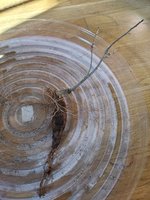I found this an interesting and somewhat relevant to the thread...
I recently did some work on my baobabs. They are succulent and very susceptible to root rot. They are not "woody" like trees we're used to so, once the tissue starts collapsing, they don't have the same sorts of compartmentalization that woody plants have...they can die off in a matter of days from root rot!
Here are the roots of a plant that was very healthy this past growing season.

You can see the black fungusy looking root next to lots of otherwise healthy roots. That root was laying on the bottom of a grow bag. Grow bags are permeable...much better than plastic pots, but maybe not as good as collandars...they drain very well. These babs were all in DE which drains very well. This part of the root was staying too wet for too long and suffocated. The tree was strong enough and the conditions higher up the pot good enough that nothing bad happened.
This case was a little more drastic!



Another baobab. This one was in a grow bag with DE sitting in a 3" deep drip tray. My guess to what happened is this: Back in the spring, we had a lot of rains. I wasn't always diligent in draining the drip trays frequently. The bulk of the root on this guy should have been well above the standing water, but the bottom 1" or so was likely in cool standing water for hours at a time. It started to rot from the bottom up. At some point, the conditions changed enough fast enough that the top of the tree was able to fend off the situation. The bulbous root was mostly just much by this point. The remaining healthy tissue sprouted new tap roots which then grew down
through the dead root! My guess is this was entirely suffocation and fungus hadn't taken hold before the overly wet conditions dried up, otherwise, I think the entire tree would have died. Instead, the tree recovered and grew fine for the rest of the season until it naturally went dormant about a month or two ago.
By contrast, I grow my banana tree (herb) in Miracle grow which holds way to much water in our wet springs but is needed most the rest of the year. I do need to repot it every year for other reasons, but I can tell by the smell whether the soil went anaerobic or not. If it had gone anaerobic, it smells strongly of sulfur! Even when the soil is a wet mucky mass that reeks, I rarely find root rot on that plant. The peat may be rotting like mad, but the banana roots are often still white and plump as can be!
So, yes, I believe the root's reaction to lack of oxygen is the primary concern. Even though we call it "rot", it may have little to do with pathogens...at least initially. But, once there is unprotected tissue, pathogens can move in quickly!





